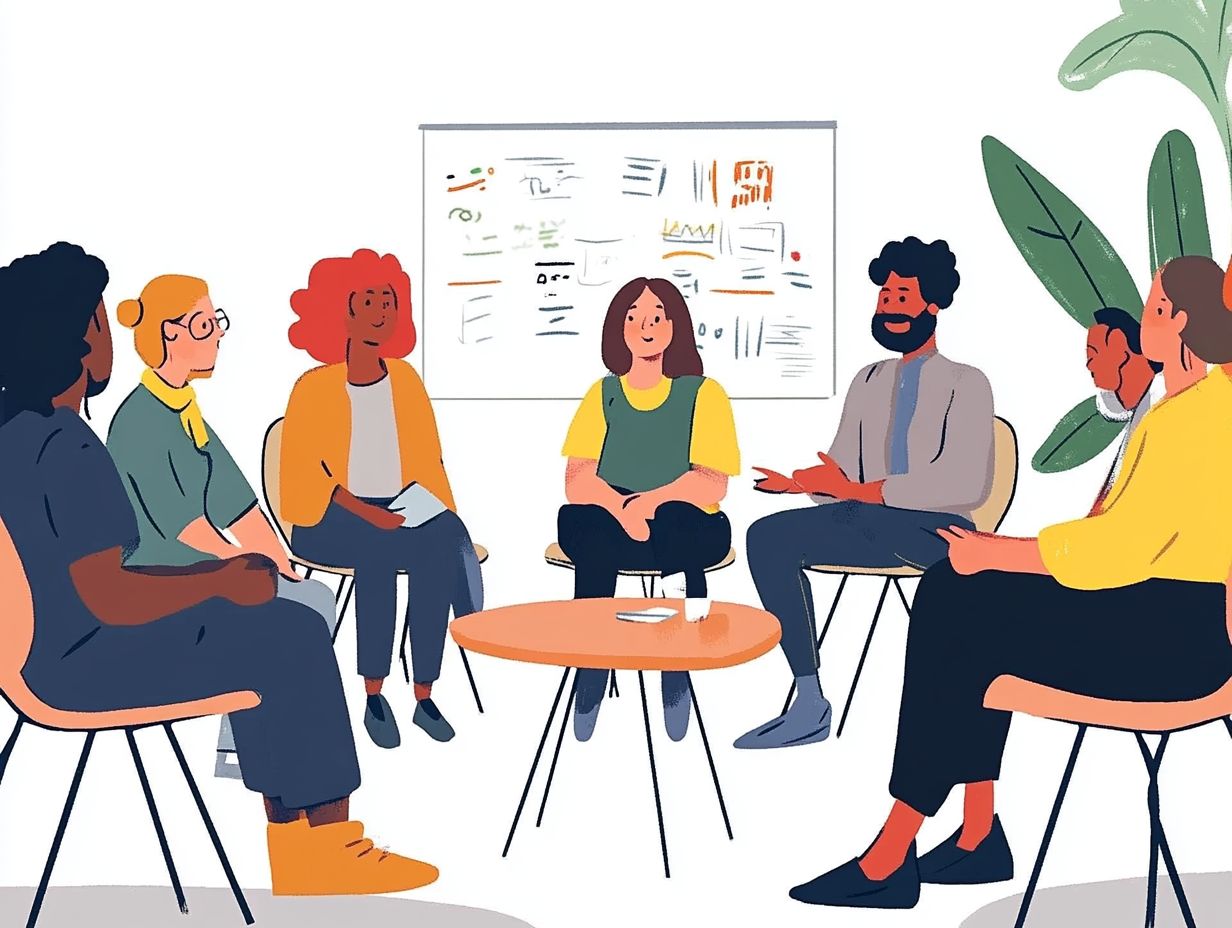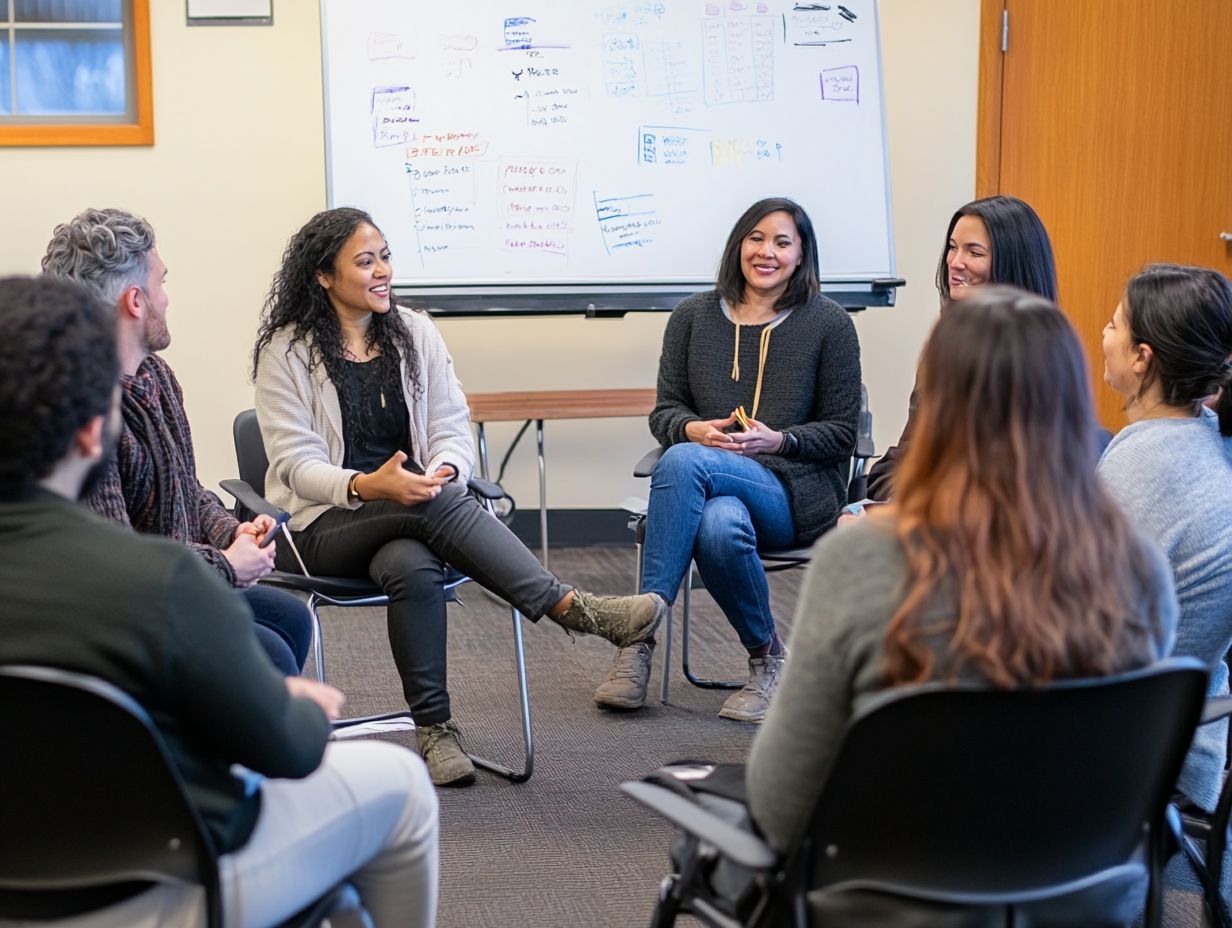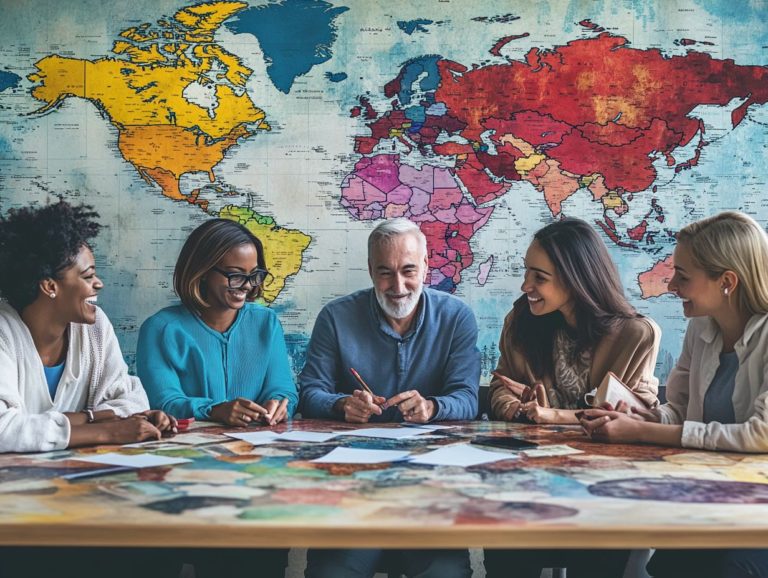How to Create a Cultural Adjustment Support Group
Cultural adjustment can feel like an uphill battle. It often brings challenges that may leave you feeling isolated and overwhelmed.
This article reveals how you can transform your experience through support groups! You ll learn the intricacies of cultural adjustment and the advantages of forming a support group.
We ll walk you through essential steps to create a nurturing community tailored to your needs.
Discover how a support group can cultivate connections and offer ongoing encouragement, helping everyone navigate their cultural journey together with confidence and resilience.
Contents
- Key Takeaways:
- Understanding Cultural Adjustment
- Benefits of a Support Group
- Creating a Support Group
- Activities and Discussions for the Group
- Maintaining the Group
- Frequently Asked Questions
- What is a cultural adjustment support group?
- Why is it important to create a cultural adjustment support group?
- Who can join a cultural adjustment support group?
- How can I create a cultural adjustment support group?
- What are the benefits of joining a cultural adjustment support group?
- Are there any online cultural adjustment support groups available?
Key Takeaways:

- Joining a cultural adjustment support group can help individuals navigate challenges and find a sense of belonging.
- A support group can provide a safe space for members to share experiences, learn coping strategies, and build a support network.
- Effective group activities and discussions, along with clear guidelines and continued support, are key to maintaining a successful cultural adjustment support group.
Understanding Cultural Adjustment
Understanding cultural adjustment is essential for immigrant and refugee families as they adapt to new environments. They often face a labyrinth of emotional and social challenges.
When encountering diverse cultural experiences, it’s common for these families to experience trauma and grief. This highlights the urgent need for support that respects cultural differences and mental health services that honor their unique identities and backgrounds.
Community resources are pivotal in easing this adjustment process. They offer coping strategies that cultivate resilience and cultural humility, helping individuals discover their rightful place within the community.
Defining Cultural Adjustment and Its Challenges
Cultural adjustment is the intricate process you navigate as you, whether an immigrant or a refugee, adapt to new social, cultural, and linguistic landscapes. This journey can be fraught with challenges at every turn.
You may grapple with different communication styles, as each culture carries its own norms. This can lead to misunderstandings or feelings of isolation. Your identity plays a pivotal role in this adjustment as you strive to honor your cultural heritage while integrating into your new community.
Economic pressures, discrimination, and the emotional weight of leaving familiar surroundings can complicate this process further. You might face hurdles related to language barriers, educational systems, and access to employment, making your transition feel even more daunting.
You need to understand these dynamics to foster empathy and support within society. This understanding creates a more welcoming environment for everyone involved.
Benefits of a Support Group
Support groups provide a distinctive environment for individuals, especially immigrant and refugee families, to share experiences and cultivate resilience through community support. This nurturing space fosters emotional well-being during the often challenging process of cultural adjustment.
How a Support Group Can Help
A support group offers you a sanctuary to share your experiences in a safe environment, cultivate peer support, and gain invaluable coping strategies to navigate emotional challenges.
In this nurturing space, you can openly discuss your feelings, significantly reducing burdensome feelings of isolation and loneliness. By engaging with others who understand your struggles, you tap into a rich reservoir of collective wisdom born from shared experiences.
This peer support provides emotional validation and promotes the exchange of practical strategies that others have found effective. Support groups connect you with valuable community resources, including mental health services, workshops, and counseling options. This enables you to take proactive steps toward enhancing your mental well-being.
Embrace the journey join a support group today and start building your community!
Creating a Support Group

Creating a support group requires careful planning. Begin by understanding the unique needs of your community, establishing clear guidelines, and ensuring that the group remains culturally sensitive to effectively cater to immigrant and refugee families seeking community support and advocacy.
This thoughtful approach will help foster a welcoming environment where everyone feels valued and supported.
Identifying Potential Members
Identifying potential members for a support group involves a deep understanding of the unique needs and identities of immigrant and refugee families. This ensures that the group remains inclusive and fosters meaningful relationships among participants.
You ll want to actively reach out to various communities, forming partnerships with local organizations, cultural centers, and schools that serve these families. By genuinely listening to their experiences and challenges, you can cultivate a welcoming atmosphere where individuals feel safe to share their thoughts and concerns.
Building trust is essential; therefore, employing methods that respect different cultures that resonate with diverse backgrounds is key.
Considering language barriers and accessibility will enhance the support you offer, ultimately fostering a sense of belonging within the group and enabling members to lean on one another.
Establishing Group Guidelines
Establishing group guidelines is essential for ensuring emotional safety and building trust within the support group. This allows you to engage openly and participate actively in discussions.
These guidelines create a framework that fosters a respectful environment where you feel valued and heard. When you understand the expectations surrounding confidentiality and respectful communication, you re more likely to share your thoughts and experiences without the fear of judgment.
This sense of safety encourages your participation and strengthens the community bond as you collectively navigate struggles and triumphs.
Ultimately, clear guidelines not only enhance the quality of interactions but also create a vibrant culture of mutual support where healing and growth thrive!
Activities and Discussions for the Group
Join us for engaging activities that cultivate meaningful connections! These will help you share coping strategies and leverage community resources to support your adjustment process.
Effective Group Exercises
- Guided storytelling: Share personal narratives that reflect your cultural background, fostering empathy and understanding among group members.
- Creative expression: Use art or music to articulate feelings that are often challenging to verbalize, facilitating a deeper connection to both yourself and your community.
- Mindfulness practices: Engage in group meditation or breathing exercises to elevate your emotional awareness, creating a harmonious atmosphere that promotes healing.
Through these thoughtfully designed sessions, the support group not only aids in your emotional recovery but also strengthens the cultural bonds among all participants.
Topics for Group Discussions

Group discussions should focus on common challenges of cultural adjustment.
Explore coping strategies and emotional identification to enrich understanding among participants.
In these discussions, you can navigate diverse cultural norms and address feelings of isolation or alienation.
Share effective techniques for managing stress and anxiety that often accompany this transition.
Delve into personal stories reflecting identity struggles, fostering authentic connections.
Evaluate the importance of cultural roots and how they shape self-perception.
Learn ways to build strength that enhance emotional well-being.
Creating a supportive and open environment enriches each member’s journey toward holistic adjustment.
Maintaining the Group
Maintaining the group’s cohesion and emotional safety requires your commitment to addressing conflicts.
Offer ongoing support and advocate for each member’s needs within a nurturing environment.
This essential endeavor fosters a sense of belonging and security for everyone involved.
Addressing Conflicts and Challenges
Addressing conflicts within your support group is vital for maintaining emotional safety.
Utilizing trust-building techniques, methods that help members feel secure and connected, can help navigate challenges effectively.
Create an environment where members feel secure to express their thoughts and emotions.
Implementing structured communication practices encourages openness and minimizes misunderstandings.
Active listening is crucial, as it allows individuals to feel heard and validated.
Establish ground rules to guide discussions, ensuring that everyone recognizes the importance of respect and empathy.
When conflicts arise, focusing on collaborative problem-solving fosters a sense of community.
This approach not only resolves immediate issues but strengthens the overall bond within the group.
Promote long-term emotional safety through mutual support.
Continuing Support for Members
You must continue supporting each other for lasting growth!
Continuing support for members is vital, reinforcing emotional backing.
This ongoing encouragement cultivates a safe space for sharing struggles.
When you feel supported, you re more likely to engage in discussions and share valuable insights.
Facilitators play a crucial role by connecting you to local organizations and professionals specializing in mental health.
By tapping into community resources like counseling services, workshops, or helplines you enable yourself for a holistic approach to well-being.
Frequently Asked Questions
What is a cultural adjustment support group?

A cultural adjustment support group helps individuals adapt to new cultures by providing emotional and social support.
Why is it important to create a cultural adjustment support group?
Creating a cultural adjustment support group helps individuals feel less isolated while adapting to a new culture.
It provides a safe space for sharing experiences and receiving support from others who understand their struggles.
Who can join a cultural adjustment support group?
Anyone going through cultural adjustment can join a cultural adjustment support group.
This includes immigrants, international students, and individuals who have recently moved to a new country.
How can I create a cultural adjustment support group?
To create a cultural adjustment support group, reach out to people interested in joining. Partner with organizations or schools that serve immigrant or international communities.
Set a regular meeting schedule. Provide a safe space for members to share and support each other.
What are the benefits of joining a cultural adjustment support group?
Joining a cultural adjustment support group helps you feel connected and supported. You ll also learn from others’ experiences and gain helpful insights on navigating a new culture.
Are there any online cultural adjustment support groups available?
Yes, many online cultural adjustment support groups exist. These communities offer support for those without access to in-person groups and connect individuals worldwide facing similar challenges.
Join a support group now and start your journey toward successful cultural adjustment!






